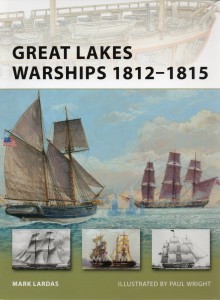 By Mark Lardas, Osprey Publishing, Oxford, United Kingdom (2010)
By Mark Lardas, Osprey Publishing, Oxford, United Kingdom (2010)
Reviewed by Diana L. Ahmad, Ph.D.
For a book of only forty-eight pages, this publication provides an excellent overview of the Great Lakes ships of the War of 1812. An amateur historian, the author, Mark Lardas, trained as a Naval Architecture and Marine Engineer, but worked at the Johnson Space Center for a time. Lardas devotes as much time to describing the vessels as he does to explaining the battles in which the ships participated.
At first, the British and American navies used ocean-going vessels for Great Lakes fighting; however, soon ships were built on the lakes using the timbers, materials, and labor available in the area. Salt-water ships used a different design than their fresh-water cousins as ships operating in the Great Lakes did not need to fear shipworms that bored through the wooden hulls. Also fresh-water ships did not need large storage spaces for drinking water and supplies as they were rarely more than two days away from a harbor for food stuffs and drinking water could be obtained by dragging buckets behind the ships as they sailed. The author noted that lakes’ warships were less stable than ocean vessels because of the difference in the ships’ centers of gravity. Without needing to carry heavy supplies and not being copper-bottomed, the center of gravity was much higher on the Great Lakes vessels making them less stable. Many of the ships, on both sides of the conflict, started with few guns and few sailors. Initially, the British and the Americans used members of the Army to man their ships. The author’s description of wartime shipbuilding well demonstrates the difficulties the two sides had in building the ships, such as the non-availability of seasoned timber, many different types of woods used, and the lack of experienced ship builders.
In addition to the trials and tribulations of building or altering vessels for use as naval ships operating on fresh-water, the author well describes the operations on the lakes. He explains the actions of the British, as well as those of the Americans. Although providing little new information, the author well-describes the major battles, the important naval commanding officers, and the results of the battles. Many of the ships were captured by the opposing side, refitted and renamed and sent back into battle. Lardas’ ability to easily follow the ships from one battle to the next and from one side of the conflict to the other is amazing. Precisely how many vessels were involved in the fresh-water battles is uncertain because of the constant renaming of the ships.
The book provides wonderful illustrations from such collections as the Library of Congress, the United States Navy History and Heritage Command, and his own collection. These illustrations depict the officers of the ships, ships in action, as well as the interior of the vessels.
The book provides thirteen pages detailing the major ships of the conflict listing their displacement, armament, dimensions, and complement, as well as when they were built and entered the conflict. Within this listing, the author additionally gives readers the names of the ship builders when that information was known. The array of vessel types that operated in the War of 1812 in such a limited theater was astounding.
The author easily defines the nautical terms he uses throughout the book, in addition to providing a glossary. Although there are no citations, there is an excellent, albeit brief, bibliography providing readers a great place to start their more serious study of the Navy in the War of 1812. This short work gives readers a delightful beginning to their reading on the naval battles of the conflict. Without the book’s going into great detail, Lardas offers an excellent introduction to the battles, the leaders, and the builders of the vessels.
Dr. Ahmad is with Missouri University of Science and Technology at Rolla.

